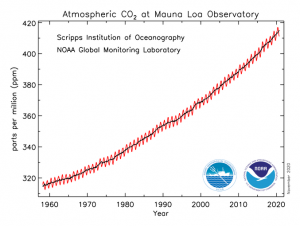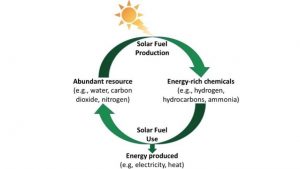Turning sunlight into a liquid fuel might sound like the fantasy machinations of a sci-fi novel. A fuel that is abundant, sustainable, storable, and a portable source of energy? The reality is possibly even more exciting. Solar fuels could use energy in sunlight to convert CO2 and methane, potent greenhouse gases, into high-value products, such as fertilizers, plastics or pharmaceuticals.
In our first post we find out how solar fuels have the potential to produce clean green hydrogen.
By Dr Miriam Regue and Dr Minsu Park, Research Associates in the Department of Chemical Engineering.
“Climate change is one of the biggest threats that we are facing today”. This is a phrase we have probably heard countless times at this stage. It may have lost some of its shock factor with repetition. Some of us may be so disheartened by its meaning that we choose to ignore it. But its message gets more urgent year by year.
Human-made CO2 emissions are one the main triggers of climate change, contributing directly to global warming. However, the evidence for just how rapid and irreversible this change is happening is stark. Over the last 20 years alone, the concentration of CO2 in the atmosphere has increased sharply. It reached a record value of 416ppm of atmospheric CO2 in June 2020, a ⁓13% increase since 2000. That is according to the Mauna Launa Observatory in Hawaii, the institution with the longest record of direct CO2 measurements in the atmosphere. These concentrations are almost double the amount of atmospheric CO2 on Earth at any time over the past 400,000 years.
This continuous rise in CO2 is directly related to the combustion of fossil fuels such as oil, natural gas or coal. Our society still uses these widely on a daily basis. Failing to reduce our reliance on fossil fuels to heat our homes, power our transport systems, and produce our goods, will cause unprecedented change, and damage, to both our way of life and the natural world alike.

Solar fuels to replace fossil fuels
Scientists, engineers and policy makers must work together, and quickly, to ensure that the energy we produce and the products that we make do not release CO2 into the atmosphere. Scientists and engineers are currently working hard to find efficient and scalable ways to producing alternative clean fuels. One revolutionary and promising alternative to conventional fossil fuels are what are known as Solar Fuels. These are produced by capturing the abundant solar energy that reaches the Earth’s surface. But as our title asks, how can we turn sunlight into a fuel?

Certain materials can absorb the energy from sunlight and transform it into another form of energy, including electric current. This is the same principle used in a solar panel. The electric current generated then splits water (H2O) into its components, hydrogen (H2) and oxygen (O2). Currently, the main industrial method for mass hydrogen production uses a process known as steam methane reforming, which emits CO2. But hydrogen gas produced from solar energy is emission-free. This is among the most promising solar fuels currently being investigated. One huge potential application of solar hydrogen is as an emission-free fuel to power the hydrogen vehicles of the future!
In fact, the European Union has recently released a green hydrogen strategy as part of the European Green Deal. This will deploy green hydrogen at a large scale to decarbonize industries, transport, buildings and power generation by 2030. Now is the perfect time to boost the potential of solar hydrogen, so it can be part of this challenging transition to a fossil-free economy.
In the next blog we will discover that in spite of the great promise and potential of solar fuels, they are still far from being commercialised.